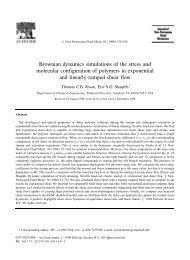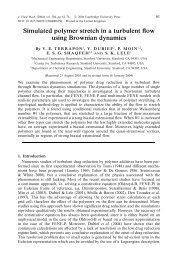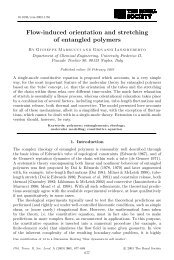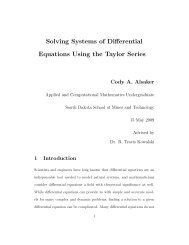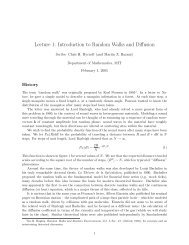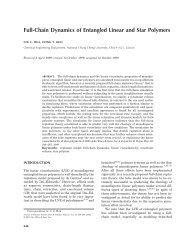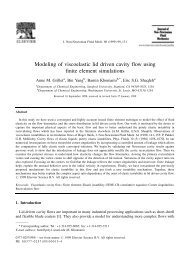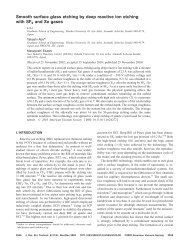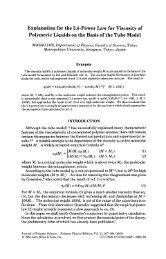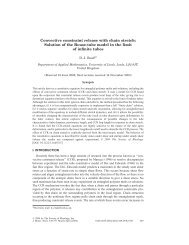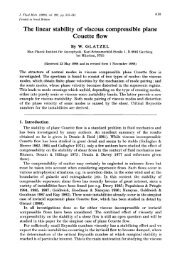A numerical study of the rheological properties of suspensions of ...
A numerical study of the rheological properties of suspensions of ...
A numerical study of the rheological properties of suspensions of ...
You also want an ePaper? Increase the reach of your titles
YUMPU automatically turns print PDFs into web optimized ePapers that Google loves.
174 M. B. Mackaplow and E. S. G. ShaqfehRadial distancelxSi,0 0.5 1 .O 1.5 2I I I2. -. 0-.. =-..00 ,.0....*..*......- *...Single stokeslet....... 0 Simulation data- aligned suspension... ........ Simulation data- isotropic suspension....... Screened stokeslet, x ....... ..................... Screened stokeslet, x............ Screened stokeslet, izI I I I II 0.1 0.2 0.3 0.4 0.5 0.6Radial distance, 1FIGURE 7. Decay <strong>of</strong> <strong>the</strong> velocity field multiplied by radial distance, r x vz, created by a point forcein a unit cell as a function <strong>of</strong> radial distance, r, in <strong>the</strong> plane perpendicular to <strong>the</strong> point force. Thesimulation results for unit cells containing both aligned and isotropic fibre <strong>suspensions</strong> are shown.The unit cell contains 150 spheroids having an aspect ratio <strong>of</strong> 663, for an effective concentration <strong>of</strong>n13 = 7. Also shown are <strong>the</strong> decay <strong>of</strong> an isolated stokeslet, and stokeslets screened on length scales<strong>of</strong> Xsim and XDA.5.2. Comparison <strong>of</strong> simulation results to experimental dataWe will now compare our simulations to published experimental data. However, all<strong>the</strong>se studies involved <strong>suspensions</strong> <strong>of</strong> cylindrical fibres. We could not directly simulate<strong>suspensions</strong> <strong>of</strong> cylinders. Instead, we simulated <strong>suspensions</strong> <strong>of</strong> spheroids having<strong>the</strong> same aspect ratios and n13 value as <strong>the</strong> <strong>suspensions</strong> used in <strong>the</strong> experiments.These simulation results were <strong>the</strong>n scaled using <strong>the</strong> ratio <strong>of</strong> <strong>the</strong> dilute <strong>the</strong>oreticalprediction for cylinders (equation (16)), to that for spheroids (equation (15)). Thisphysically corresponds to an isolated cylinder having <strong>the</strong> same particle stresslet as aspheroid with a larger aspect ratio, A,ff, where Aeff > A. However, <strong>the</strong> percentageenhancement <strong>of</strong> <strong>the</strong> stresslet due to interparticle interactions will still depend onlyon n13. We have based this conversion method on <strong>the</strong> findings <strong>of</strong> our analogous<strong>study</strong> <strong>of</strong> heat and mass transport through fibre <strong>suspensions</strong> (Mackaplow et al. 1994),where converged <strong>numerical</strong> results were obtained for both spheroidal and cylindricalfibres.We have not attempted comparisons to falling-ball rheometry studies, such as thoseby Milliken et al. (1989). Such investigations determine <strong>the</strong> ‘effective viscosity’ <strong>of</strong>fibre <strong>suspensions</strong> by measuring <strong>the</strong> fall speed <strong>of</strong> a sphere sedimenting through <strong>the</strong>suspension. The flow field created by a sedimenting sphere will induce a local fibreordering that decays away from <strong>the</strong> sphere. Since it is <strong>the</strong> fibres closest to <strong>the</strong> spherethat will have <strong>the</strong> greatest effect on its fall velocity, comparisons <strong>of</strong> <strong>the</strong>se results to oursimulations <strong>of</strong> isotropic <strong>suspensions</strong> are not meaningful. Additionally, <strong>the</strong> <strong>numerical</strong>simulations <strong>of</strong> falling-ball rheometry by Harlen, Sundarajakumar & Koch (1995)show that even in <strong>the</strong> dilute regime, fibre contacts, which we neglect, substantiallyincreases <strong>the</strong> ‘effective viscosity’. We note this was not found to be <strong>the</strong> case in sheared<strong>suspensions</strong>.



